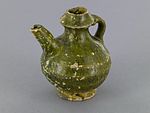Ewer
About this object
History of use
Chinese ceramics were important trade items in southeast Asia during the 11th-16th centuries and became fully integrated with ideology and ritual in Philippine societies, playing an important role in all aspects of cultural life (Langrick, p.61). Their functions were varied and included utilitarian, ceremonial and religious roles as heirlooms, and in mortuary ceremonies as burial goods and items of prestige. Chinese ceramics constitute the vast majority of burial goods excavated in the Philippines. Buried with the deceased, they acted as indicators of wealth, protected the departing spirit from evil and serving as provisions for the afterlife. Turned-over plates and bowls were used to cover certain parts of the body, establishing a protective area. In addition, many excavated ceramics were miniaturized replicas of larger, functional vessels--symbolic substitutes for provisions for the afterlife. In addition, small jarlets and bottles and other containers were used for ritual substances (oils, herbs, aromatic resins) and for food offerings necessary for the departing spirit. Most of the trade ceramics excavated in the Philippines show little or no evidence of usage before burial. Locsin divides lead-glazed wares found in the Philippines into two chronologically oriented groups. The earlier group is attributable to the Song (960 -1279) and Yuan (1260 - 1368) dynasties. According to Locsin, this group exhibits Tang-like glazes albeit with non-Tang shapes and originated from south China kiln or kilns continuing in the Tang tradition long after the Tang dynasty (618 - 906) had gone into decline (p. 1-3). There are fewer examples during the Ming dynasty (1368-1644). From the condition of trade ceramics shown in published sources and the Tecson collection, it appears that most of the wares were kiln seconds, or rejects. They were nevertheless regarded with high esteem and actively traded.
Narrative
This ewer is part of a collection of Chinese ceramics found in burial context in the Philippines and was excavated at a burial site in Lumban, Laguna Province, Philippines. Repairs were done by specialists employed by archaeologists and the Philippines National Museum. They were artists by training.
Cultural context
exchange; status; ceremonial; mortuary
Iconographic meaning
In many indigenous groups of the Philippines, supernatural power was attributed to Chinese ceramics because of the ringing sound emitted when lightly tapped and their vitreous, shiny glazed surfaces which impart an impermeable quality. The ringing sound was seen as a magical voice able to attract the attention of powerful ancestor spirits. Their impermeable and seemingly imperishable surfaces were believed to have great protective power against all kinds of influences, from evil spirits to poisons (Langrick, p. 55-56).
Specific techniques
Lead glaze is a glaze material, containing silica in the form of sand or quartz, fused by means of an oxide of lead. It fires at a low temperature of about 800 degrees centigrade and may be used on pottery but not on porcelain unless it has first been fired without glaze to the usual high temperature of approximately 1,200 or 1,250 degrees centigrade (Medley, 1977, p. 74). Chatter marks are radiating ridges, varying in prominence, on the base of a circular vessel. It is a fault in manufacture, which occurs in cutting the foot ring, and is due to holding the foot turning tool insufficiently firmly or at the wrong angle (Medley, 1977, p. 62).
Physical description
Green lead glazed ewer with slightly flared foot and a round body that goes into a neck that flares into another shoulder. A spout is attached to shoulder and handle is attached to shoulder and secondary shoulder in neck.
Date Made
Song Dynasty (960-1279)
Date Acquired
16 Nov 1987
How Acquired
Donated
Credit Line
Measurements
7.2 x 6.7 cm
Object Number
Ia280
